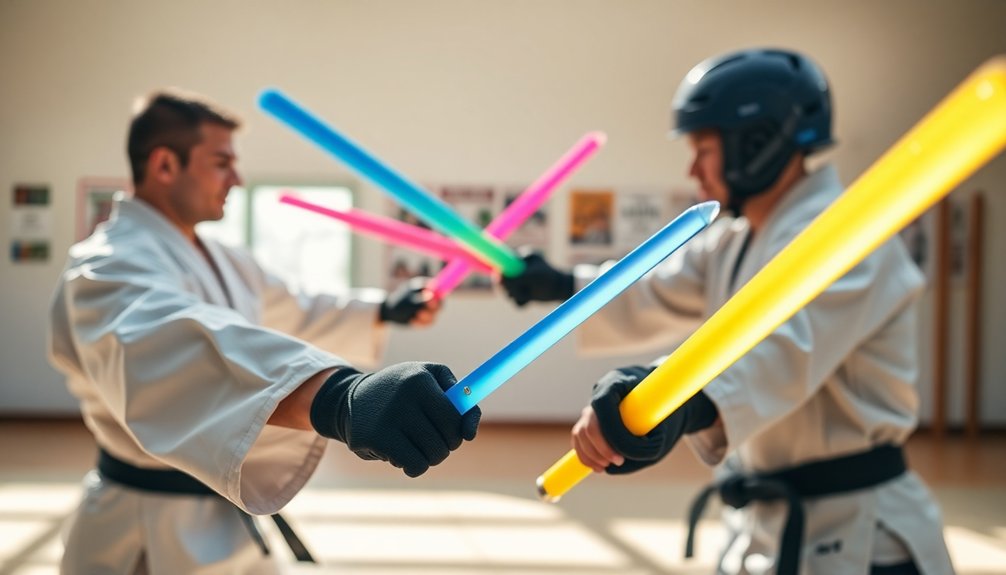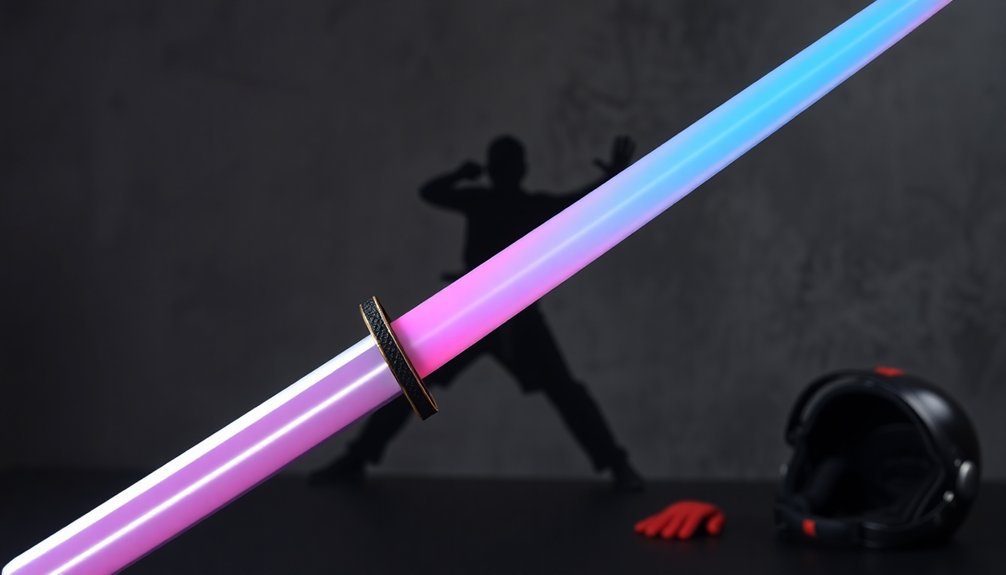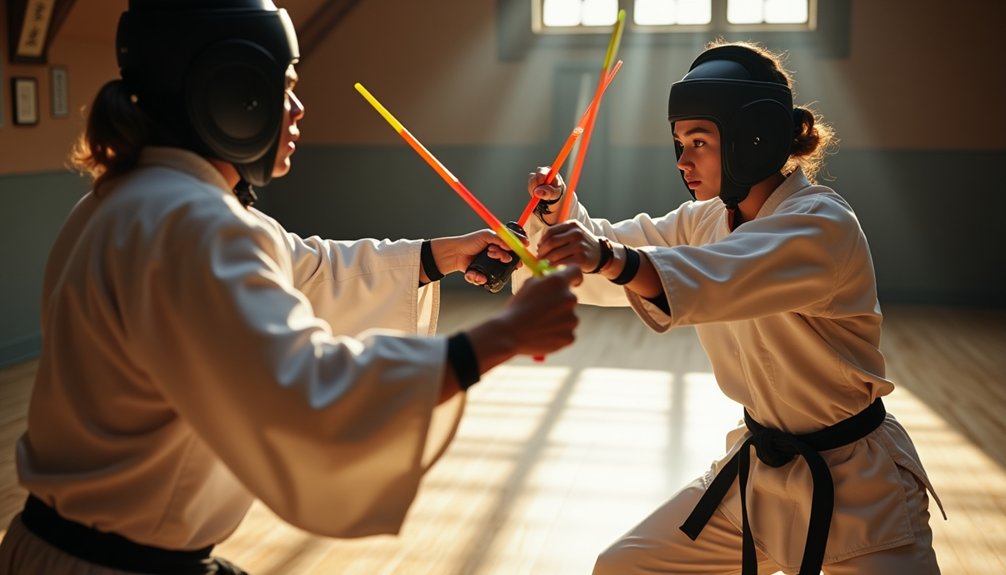Polypropylene swords are excellent for training thanks to their lightweight and durable design. They're safer than wooden swords, especially if you modify sharp points and seams on European models. The Japanese versions offer better maneuverability, allowing for finesse during practice. Cold Steel's polypropylene swords stand out for their durability, handling rigorous sparring without major issues. You'll find that they minimize injury risks, enabling you to focus on honing your skills. Whether you choose Japanese or European styles, both have unique advantages. If you want to explore more about their features and performance, there's plenty more to consider.
Key Takeaways
- Polypropylene swords are lightweight and durable, making them ideal for safe training without the risk of breakage.
- Japanese models offer enhanced control and finesse, while European designs may hinder agility due to their bulkiness.
- Safety modifications, like sanding sharp points, are crucial to prevent injuries during sparring.
- Cold Steel polypropylene swords exhibit high resilience, outperforming competitors in durability and performance for rigorous training.
- Investing in quality polypropylene swords enhances overall training experience by reducing injury risks and improving skill development.
Features of Polypropylene Swords
Polypropylene swords offer several key features that make them an excellent choice for training. First and foremost, their lightweight and durable construction means you can practice safely without worrying about breakage during sparring. Unlike wooden weapons, these swords boast superior durability and longevity, ensuring they withstand contact with steel blades, which is crucial for effective training sessions. Additionally, polypropylene is a non-toxic material that is FDA-approved for food contact, providing an added layer of safety for practitioners.
If you're seeking usability, the Japanese models are particularly noteworthy. They're designed to be slender and easy to handle, allowing for smoother movements and better control. This can be especially beneficial when you're refining your techniques.
On the other hand, European polypropylene swords tend to be bulkier, resembling oversized weapons. While they may look impressive, this can lead to less effective sparring experiences, making them hard to find for practitioners who prioritize agility and precision.
To enhance safety during partner training, it's essential to make safety modifications, such as sanding down sharp points and seam lines on European swords. This attention to detail ensures you and your training partners can enjoy a safe environment while honing your skills.
Japanese vs. European Designs
When comparing Japanese and European designs of polypropylene swords, you'll quickly notice significant differences that can impact your training experience.
Japanese polypropylene swords are designed to be slender and lightweight, making them easier to handle. This allows for greater finesse during practice and sparring, which is crucial for developing skills.
In contrast, European polypropylene swords tend to be bulkier and have a mass distribution that gives them a club-like feel. This can hinder your ability to move fluidly and control your strikes effectively.
Additionally, the sharp points and seams on European designs pose safety risks, requiring you to modify them by sanding down these areas before using them for training.
On the other hand, Cold Steel's Japanese models deliver hard hits with less weight, enhancing both safety and performance during practice sessions. Moreover, incorporating durable materials recycled plastic into polypropylene swords can provide a more eco-friendly alternative to traditional sword materials.
Addressing Safety Modifications

Safety modifications are crucial when using European polypropylene swords, as these weapons often come with sharp points and seam lines that can lead to injuries during training.
To ensure a safer sparring experience, it's essential to sand down any sharp points and seams. This simple yet effective step can significantly reduce the risk of cuts or injuries when you're training with a partner.
Neglecting these safety modifications can make your polypropylene swords still quite dangerous. Inadequate adjustments can result in serious injuries, rendering the swords unsuitable for safe use.
By taking the time to modify your equipment, you not only protect yourself but also your training partners.
Properly modified polypropylene swords enhance the overall training experience. You'll find that with smoother edges, you can focus on techniques rather than worrying about potential injuries.
This way, you can engage in sparring with more confidence, knowing that you've prioritized safety.
It's also important to note that, similar to plastic saw blades, polypropylene swords may not be as durable as their metal counterparts, but they can be a safer alternative for training purposes, particularly when sharp edges are properly addressed.
Evaluating Durability and Performance
In evaluating durability and performance, it's clear that Cold Steel polypropylene swords stand out for their resilience. These swords can withstand contact with steel blades without significant damage, making them a reliable choice for training. Unlike wooden weapons, they offer superior longevity, so you won't have to replace them frequently.
Their minimal flex during thrusting impacts results in harder hits, enhancing your sparring experience. Compared to brands like Black Fencer and Purple Heart, Cold Steel's polypropylene swords have unique flexibility characteristics that influence handling and performance.
The material used for these swords, such as high-density polyethylene, enables them to exhibit strength and resilience.
Here's a comparison of some key aspects:
| Feature | Cold Steel | Black Fencer | Purple Heart |
|---|---|---|---|
| Durability | Very High | Moderate | Moderate |
| Flexibility | Minimal | Moderate | High |
| Longevity | Excellent | Good | Fair |
While I've never encountered significant issues with their durability, remember that safety modifications, such as sanding down sharp points, are essential to prevent injuries during partner training. This attention to detail ensures you get the most out of your training sessions while staying safe.
Final Thoughts on Training Use

Training with polypropylene swords can be an effective way to hone your skills while minimizing risk. When choosing a sword, consider the type that best suits your training style. Japanese polypropylene swords are often the preferred option due to their lightweight and slender design, which enhances handling and maneuverability. This makes them ideal for both beginners and advanced practitioners.
On the other hand, if you opt for European polypropylene swords, be cautious. They can pose safety risks if not modified properly. Make sure to sand down any sharp points and seams before use to prevent injuries during sparring.
Cold Steel polypropylene swords are also a solid choice since they're durable enough to withstand contact with steel blades. While you might encounter some chips and scuffs, their resilience makes them reliable for rigorous training.
Ultimately, while polypropylene swords are cost-effective and readily available, investing in a Japanese model can greatly improve your training experience. By prioritizing safety and performance, you'll not only enhance your skills but also ensure a safer environment for all participants. Furthermore, choosing a polypropylene sword with a stainless steel or ceramic-coated material handle can help reduce the risk of chemical exposure and leaching associated with certain plastics.
Frequently Asked Questions
Is Polypropylene Good for Training Swords?
Polypropylene's lightweight and durable nature makes it great for training swords. You'll find them easy to handle, and they can withstand repeated impacts, providing a safer and more effective training experience without the risk of breaking.
Are Polypropylene Swords Sharp?
Polypropylene swords aren't sharp by design; they're meant to be safe for training. However, some models may arrive with sharp points or edges that you'll need to modify for optimal safety during use.
Is Polypropylene Better Than Wood?
When comparing polypropylene to wood, you'll find polypropylene is often more durable and safer. It won't splinter, is lighter to handle, and typically lasts longer, making it a preferable choice for training and sparring.
What Were Training Swords Made Of?
Training swords were traditionally made from materials like wood, leather, or rattan. These options provided safety and flexibility, allowing you to practice techniques effectively without the risk of injury from heavier, metal blades.

